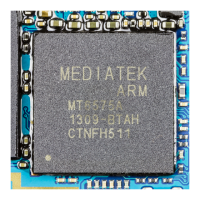System Control
ARM DDI 0388I Copyright © 2008-2012 ARM. All rights reserved. 4-21
ID073015 Non-Confidential
4.3.4 Revision ID register
The REVIDR characteristics are:
Purpose Provides implementation-specific minor revision information that can
only be interpreted in conjunction with the MIDR.
Usage constraints The REVIDR is:
• a read-only register
• common to the Secure and Non-secure states
• only accessible in privileged modes.
Configurations Available in all configurations.
Attributes See the register summary in Table 4-2 on page 4-5.
Figure 4-4 shows the REVIDR bit assignments.
Figure 4-4 REVIDR bit assignments
Table 4-31 shows the REVIDR bit assignments.
To access the REVIDR, read the CP15 register with:
MRC p15, 0, <Rt>, c0, c0, 6; Read Revision ID Register
4.3.5 Cache Size Identification Register
The CCSIDR characteristics are:
Purpose Provides information about the architecture of the caches selected by
CSSELR.
Usage constraints The CCSIDR is:
• only accessible in privileged modes
• common to the Secure and Non-secure states.
Configurations Available in all configurations.
Attributes See the register summary in Table 4-2 on page 4-5.
Figure 4-5 on page 4-22 shows the CCSIDR bit assignments.
Table 4-31 REVIDR bit assignments
Bits Name Function
[31:0] ID number Implementation-specific revision information.
The reset value is determined by the specific Cortex-A9 implementation.

